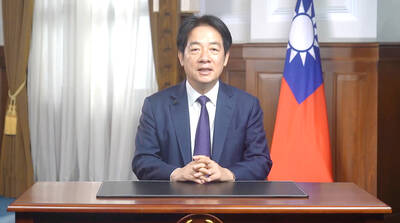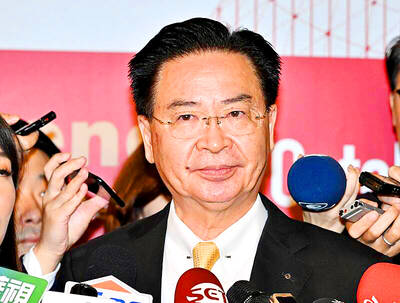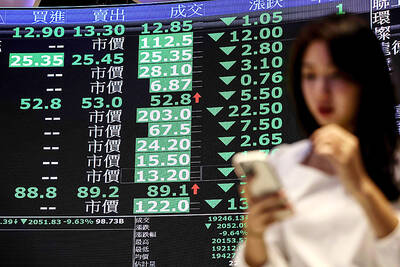China said its military seized a US Navy unmanned underwater glider in the South China Sea, but it would give the drone back.
However, US president-elect Donald Trump later said on Twitter that the Chinese government should be told “we don’t want the drone they stole back.”
That came after US officials had confirmed that they “secured an understanding” for the return of the device.
The Chinese navy on Thursday seized the drone, which the US Pentagon said was being operated by civilian contractors to conduct oceanic research.
The US lodged a formal diplomatic complaint and demanded the drone back.
Chinese Ministry of National Defense spokesman Yang Yujun (楊宇軍) late on Saturday issued a statement saying that a Chinese navy lifeboat discovered an unknown device in the South China Sea on Thursday.
“In order to prevent this device from posing a danger to the safe navigation of passing ships and personnel, the Chinese lifeboat adopted a professional and responsible attitude in investigating and verifying the device,” Yang said.
The statement said that after confirming that the device was a US unmanned submerged device, “China decided to transfer it to the US through appropriate means.”
The US said that “through direct engagement with Chinese authorities, we have secured an understanding that the Chinese will return” the uncrewed underwater vehicle, said Peter Cook, a spokesman for US Secretary of Defense Ashton Carter.
However, Trump, after holding a rally to thank supporters for his election victory, took to Twitter to criticize the deal.
“We should tell China that we don’t want the drone they stole back.- let them keep it!” the president-elect tweeted on Saturday evening.
He earlier in the day had blasted the seizure.
Misspelling “unprecedented,” he tweeted: “China steals United States Navy research drone in international waters — rips it out of water and takes it to China in unpresidented act.”
He later reissued the tweet, correcting the spelling.
The US said China’s “unlawful seizure” came in international waters.
However, China pointedly accused the US of long-sending ships “in China’s presence” to conduct “military surveying.”
“China is resolutely opposed to this and requests the US stop such activities,” it said. “China will continue to maintain vigilance against the relevant US activities and will take necessary measures to deal with them.”
The drone was seized while collecting unclassified scientific data about 92km northwest of Subic Bay near the Philippines in the South China Sea, which China claims virtually in its entirety, Pentagon spokesman Navy Captain Jeff Davis said on Friday.
“It is ours. It’s clearly marked as ours. We would like it back, and we would like this not to happen again,” Davis told reporters.
He said the drone costs about US$150,000 and is largely commercial, off-the-shelf technology.

ACTION PLAN: Taiwan would expand procurement from the US and encourage more companies to invest in the US to deepen bilateral cooperation, Lai said The government would not impose reciprocal tariffs in retaliation against US levies, President William Lai (賴清德) said yesterday, as he announced five strategies to address the issue, including pledging to increase Taiwanese companies’ investments in the US. Lai has in the past few days met with administrative and national security officials, as well as representatives from various industries, to explore countermeasures after US President Donald Trump on Wednesday last week announced a 32 percent duty on Taiwanese imports. In a video released yesterday evening, Lai said that Taiwan would not retaliate against the US with higher tariffs and Taiwanese companies’ commitments to

‘SPECIAL CHANNEL’: Taipei’s most important tasks are to stabilize industries affected by Trump’s trade tariffs and keep negotiations with Washington open, a source said National Security Council Secretary-General Joseph Wu (吳釗燮) arrived in the US for talks with US President Donald Trump’s administration, a source familiar with the matter said on Friday. Wu was leading a delegation for a meeting known as the “special channel,” the Financial Times reported earlier. It marked Trump’s first use of the channel since returning to the White House on Jan. 20. Citing a source familiar with the matter, the Financial Times reported that Minister of Foreign Affairs Lin Chia-lung (林佳龍) was also a part of the delegation. The visit came days after China concluded war games around Taiwan and amid Trump’s

Intelligence agents have recorded 510,000 instances of “controversial information” being spread online by the Chinese Communist Party (CCP) so far this year, the National Security Bureau (NSB) said in a report yesterday, as it warned of artificial intelligence (AI) being employed to generate destabilizing misinformation. The bureau submitted a written report to the Legislative Yuan in preparation for National Security Bureau Director-General Tsai Ming-yen’s (蔡明彥) appearance before the Foreign Affairs and National Defense Committee today. The CCP has been using cognitive warfare to divide Taiwanese society by commenting on controversial issues such as Taiwan Semiconductor Manufacturing Co’s (TSMC, 台積電) investments in the

HELPING HAND: The steering committee of the National Stabilization Fund is expected to hold a meeting to discuss how and when to utilize the fund to help buffer the sell-off The TAIEX plunged 2,065.87 points, or 9.7 percent, to close at 19,232.35 yesterday, the highest single-day percentage loss on record, as investors braced for US President Donald Trump’s tariffs after an extended holiday weekend. Amid the pessimistic atmosphere, 945 listed companies led by large-cap stocks — including Taiwan Semiconductor Manufacturing Co (TSMC, 台積電), Hon Hai Precision Industry Co (鴻海精密) and Largan Precision Co (大立光) — fell by the daily maximum of 10 percent at the close, Taiwan Stock Exchange data showed. The number of listed companies ending limit-down set a new record, the exchange said. The TAIEX plunged by daily maxiumu in just